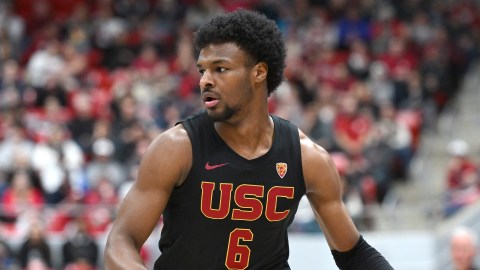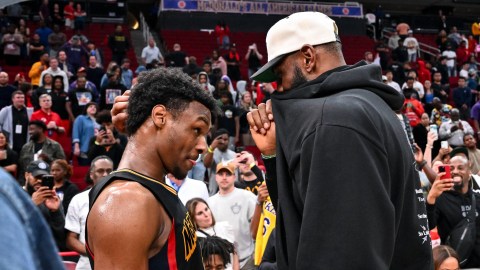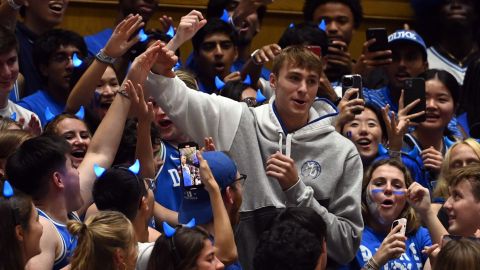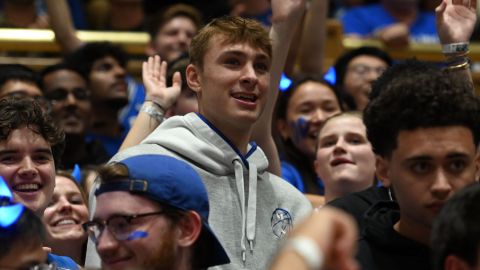 Ranking “forwards” is sort of like ranking the top “human beings.” The category is so broad, it is nearly impossible to determine which traits override others.
Ranking “forwards” is sort of like ranking the top “human beings.” The category is so broad, it is nearly impossible to determine which traits override others.
Does a wing forward’s shooting ability outweigh a bruiser’s rebounding instincts? Does a point-forward’s court vision trump a high-jumper’s potential to finish alley-oops? Who knows?
Even NBA front offices aren’t great at it, if past drafts are any indication.
Continuing our 2014 NBA draft week series, NESN.com ranks the top 15 forwards available. We ranked guards on Monday and will rank centers on Wednesday, culminating with our final mock draft on draft day Thursday.
1. Andrew Wiggins, Kansas (SF/SG, 6-8, 200) — The most gifted all-around talent in the draft, Wiggins has the potential to score and defend with the best. He’s nominally a small forward but is versatile enough to be a massive off-guard in the right system and with the right personnel.
2. Jabari Parker, Duke (F, 6-8, 240) — An NBA scoring champion in the making, Parker has the vastest array of methods to put the ball in the basket of any player in the draft. He also is a great rebounder and excellent ballhandler for his size. His defensive shortcomings immediately will be a point of emphasis in the pros.
3. Aaron Gordon, Arizona (F, 6-8, 210) — Whichever forward position he ends up manning, Gordon seems like a surefire All-Defensive Team player in the future. His energy, length and understanding of defensive spacing are elite. If he just improves his jump shot, he could become a two-way force.
4. Noah Vonleh, Indiana (PF, 6-10, 240) — One of the youngest players in the draft, Vonleh offers more hope of upside than any player this side of Joel Embiid. Vonleh’s mixture of long arms and a nice mid-range jump shot should give him the ability to score both inside and outside once his game gets more polish.
5. Julius Randle, Kentucky (PF, 6-9, 225) — On one hand, Randle is a tenacious rebounder and a tough cover inside due to his left-handedness. On the other hand, he is not much of a defender and will be undersized as an NBA four. Randle will really have to work to carve out space down low, but his track record suggests that’s exactly what he will do.
6. Dario Saric, Croatia (SF, 6-10, 225) — People who have seen Saric play are ridiculously high on him. Just 20 years old, Saric has been compared to Hedo Turkoglu — the really good version who played in Orlando, not the broken-down version of recent years. He can shoot, he can dribble and, man, can he pass. He is stuck overseas for two more years, but he could be worth the wait.
7. T.J. Warren, NC State (F, 6-8, 215) — Warren’s scoring ability has overshadowed his instincts on defense, where he knows how to position himself in the post and has a knack for jumping passing lanes. He somehow scored 24.9 points per game despite having a shaky jumper.
8. Kyle Anderson, UCLA (SF, 6-9, 230) — Anderson is not a leaper or a sprinter, which might hurt him in other drafts. This year, though, the relatively non-athletic ‘tweener type is in vogue. Anderson’s court vision and jumper give him intriguing point-forward potential.
9. Doug McDermott, Creighton (F, 6-8, 210) — All the knocks against McDermott reek of scouts overthinking the issue. True, McDermott doesn’t look the part of an NBA wing, but he can knock down shots from anywhere. Last time we checked, that was a useful skill.
10. Rodney Hood, Duke (SF/SG, 6-8, 180) — Similar to McDermott, Hood is a pure shooter who struggles with virtually every other aspect of the game. But Hood isn’t nearly as versatile a shooter as McDermott. If he can’t learn to shoot from the corners, there might not be a place for him.
11. Adreian Payne, Michigan State (PF, 6-10, 245) — If a team is in the market for a stretch-four that can help right away, Payne is their man. Despite a lung condition that limits his endurance, Payne is hard-working and an excellent finisher, either from three feet or 23 feet.
12. Cleanthony Early, Wichita State (SF, 6-8, 220) — Early is not a good rebounder or defender on paper, but somehow he always played like one in the many big games he played in for the Shockers. Combine this ability to raise his game with a promising shooting stroke and he is a championship-caliber role player in the making.
13. K.J. McDaniels, Clemson (SF, 6-6, 200) — As fierce a wing defender as there is in this draft, McDaniels can both lock down his man and block a pull-up if need be. (These are not the same thing. Plenty of good shot-blockers are not good one-on-one defenders, and vice versa. McDaniels is both.)
14. Jerami Grant, Syracuse (SF, 6-8, 210) — We now return to the more prototypical jumping-bean portion of our rankings. As is typical of gifted young pogo sticks like Grant, though, he will need to learn to harness his talents within the pro game. His defense also is a complete unknown due to his playing in Syracuse’s zone system.
15. Glenn Robinson III, Michigan (SF, 6-7, 210) — He always knows where to be off the ball, which is fortunate, because he doesn’t always know what to do with the ball when he has it. Although Robinson struggles to create his own shot, he could bedevil defenses with his cutting ability if he is paired with a pass-first point guard.
Photo via Twitter/@ESPNU



